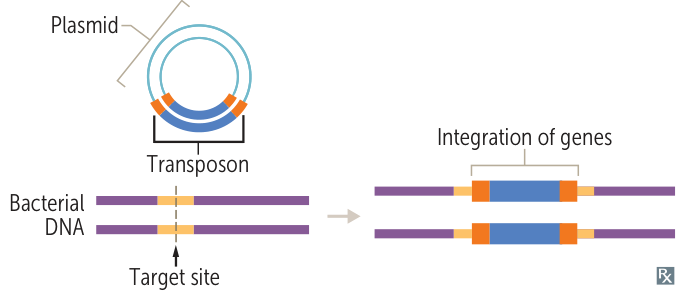
- Core Concept: Plasmids are small, circular, extrachromosomal, double-stranded DNA molecules found in bacteria (and some eukaryotes) that replicate independently of the host chromosome. They are not essential for basic bacterial survival but often carry genes that confer a selective advantage.
Key Features
- Structure: Circular, double-stranded DNA. Contains an origin of replication (ori), which dictates its host range and copy number.
- Replication: Replicates autonomously using host cell machinery. The number of plasmids in a cell (copy number) can range from one to hundreds.
- Gene Transfer: Plasmids are primary drivers of Horizontal Gene Transfer (HGT), the movement of genetic material between bacteria outside of parent-to-daughter cell inheritance. This is crucial for rapid bacterial evolution.
Clinically Relevant Plasmid Types
-
Resistance (R) Plasmids:
- Carry genes that confer resistance to one or more antibiotics (e.g., β-lactamases).
- Clinical Significance: The primary mechanism for the spread of multidrug resistance (MDR) among pathogenic bacteria. Can be transferred between different bacterial species.
-
Fertility (F) Plasmids:
- Contain
tra(transfer) genes that code for the sex pilus and enable conjugation. - Conjugation: A process of direct cell-to-cell contact where a donor bacterium (F+) transfers the plasmid to a recipient (F-). This is the most common mechanism for HGT.
- Contain
-
Virulence Plasmids:
- Carry genes that code for virulence factors, turning a bacterium into a pathogen.
- Examples: Genes for toxins (e.g., Shiga-like toxin in EHEC), adhesins, or enzymes that damage host tissue.
-
Col Plasmids: Contain genes for bacteriocins (e.g., colicins), which are proteins that kill other bacteria, providing a competitive advantage.
Mechanisms of Horizontal Gene Transfer
- Conjugation: “Bacterial sex.” Transfer of plasmids (especially F-plasmids) through a sex pilus. The major mechanism for spreading antibiotic resistance genes.
- Transformation: Uptake of naked DNA (including plasmids) from the environment by competent bacteria.
- Transduction: Transfer of bacterial DNA (which can include plasmid DNA) from one bacterium to another via a bacteriophage (virus).
Medical & Biotechnological Significance
- Antibiotic Resistance: The rapid dissemination of R-plasmids is a major global health crisis, making infections difficult to treat. Plasmids can accumulate multiple resistance genes, creating “superbugs.”
- Genetic Engineering (Biotechnology):
- Plasmids are used as vectors to clone genes. A gene of interest (e.g., the human insulin gene) is inserted into a plasmid, which is then introduced into bacteria (like E. coli).
- The bacteria rapidly multiply, producing large quantities of the plasmid and, consequently, the desired protein (e.g., insulin).
- Selectable markers (usually an antibiotic resistance gene) are included on the engineered plasmid to allow researchers to select for bacteria that have successfully taken up the plasmid.